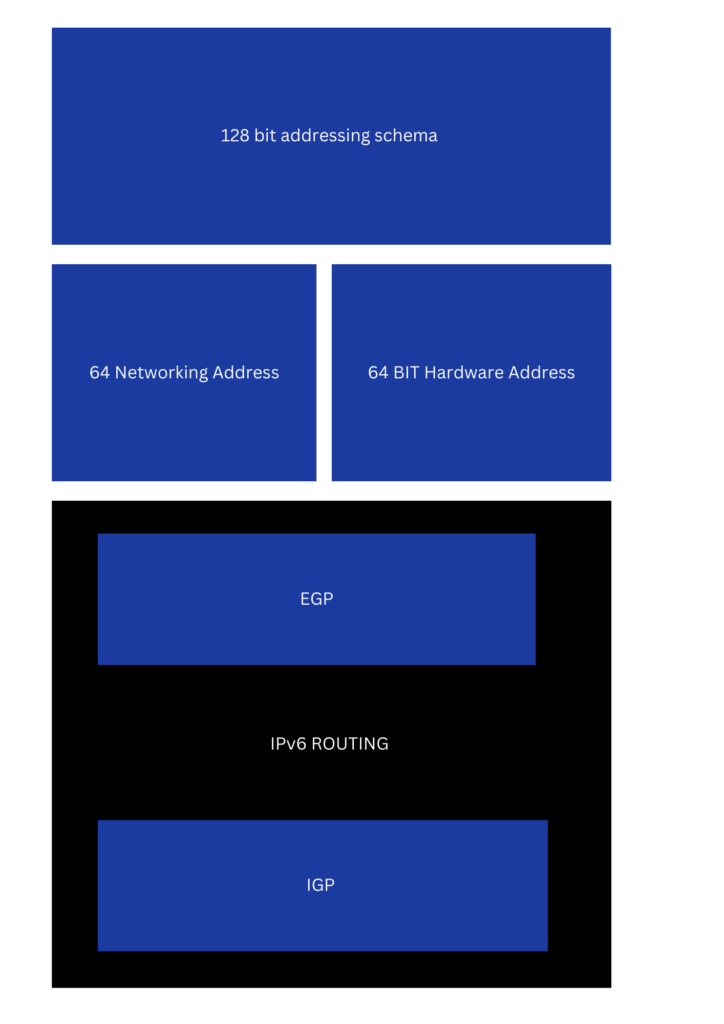The IPV6 is an addressing mode just like IPV4 but with many added features and way more addresses (Trillions of addresses). The IPV6 is designed keeping in mind the limited amount of IPV4 ADDRESSES AVAILABLE, IPV6 COMES WITH ADDITIONAL ADDRESSES AND MORE SECURITY UPGRADES. IPV6 is based on NDP and comes with IPSEC integration.
IPV6 IS BASED ON 128 BIT LONG ADDRESSING SCHEMA, IT CAN SUPPORT (340 TRILLION ) Addresses.
The networking Component of IPV6 is 64 BITS which is divided into 48 Bits (global network address) and 16 Bits blocks (Internal Network subnets). The Node components consist of 64 BITS which is the hardware address (MAC).
With the help of Flow labeling, DHCP V6 and optimal NAT, IPV6 is a modern and highly advanced addressing schema, which is designed and implemented to stay for a long time.
IPV6 is an alphanumeric addressing method that supports multicast packet flows. IPV6 Eliminates the need for NAT PROTOCOL and ensures tighter security mechanisms.
ROUTING PROTOCOLS LEVERAGED BY IPV6 : IGP (Interior Gateway Protocol) | EGP (Exterior Gateway Protocol)
IPV6 utilizes a hexadecimal system as addressing schema. The routing efficiency has increased with IPV6 ‘prefixing’ based aggregation. All the modern devices will have an IPV6 addressing schema as modern-day communication happens over IPV6.
IPv6, or Internet Protocol version 6, is a successor to IPv4, designed to address the limitations of its predecessor. IPv6 provides:
Key Features:
- Vast Address Space: IPv6 offers 128-bit addresses, providing trillions of unique addresses (3.4 x 10^38).
- Improved Security: Integrated IPsec (Internet Protocol Security) for encryption and authentication.
- Simplified Header Format: Reduced header size and improved packet processing efficiency.
- Quality of Service (QoS): Enhanced support for real-time applications.
- Mobility and Address Autoconfiguration: Simplified network renumbering and host configuration.
Design Considerations:
- Scalability: IPv6 addresses the IPv4 address exhaustion issue.
- Security: IPv6 includes built-in IPsec for secure communications.
- Mobility: IPv6 supports seamless handovers and address changes.
IPv6 Components:
- NDP (Neighbor Discovery Protocol): Manages neighbor discovery, address autoconfiguration, and duplicate address detection.
- ICMPv6 (Internet Control Message Protocol version 6): Provides error reporting, diagnostic functions, and group membership management.
IPv6 Address Types:
- Unicast: One-to-one communication.
- Multicast: One-to-many communication.
- Anycast: One-to-nearest communication.
Benefits:
- Future-Proof: Supports growing demand for IP addresses.
- Enhanced Security: Integrated IPsec and improved authentication.
- Improved Performance: Simplified header format and reduced packet overhead.
Transition Mechanisms:
- Dual-Stack: Running IPv4 and IPv6 concurrently.
- Tunneling: Encapsulating IPv6 packets within IPv4 packets.
- Translation: Translating IPv6 addresses to IPv4 addresses.
IPv6 is designed to provide a scalable, secure, and efficient Internet infrastructure for the future. It has been adopted widely across all device types as it is the most advanced addressing format. IPV6 was introduced in 1993 AND IS OPERATED IN THE SAME LAYER as IPV4 which is the network layer. IPV6 is supported by DNSes.
RFC DOCS —> 2469, 8200
Currently, manufactured equipment supports IPV6 natively, it is supported by MC OS, WINDOW, and LINUX DISTROS.
Diagram

The article above is rendered by integrating outputs of 1 HUMAN AGENT & 3 AI AGENTS, an amalgamation of HGI and AI to serve technology education globally.